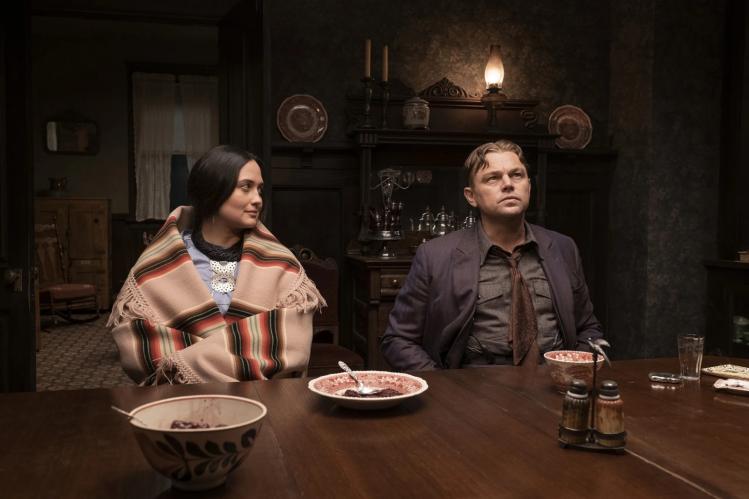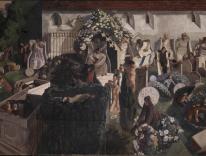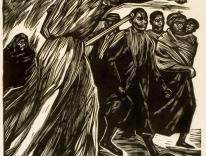
Martin Scorsese is a more wide-ranging director than he gets credit for, yet one theme unites all his movies: the inexpugnable human capacity for violence. Violence is front and center in plenty of Scorsese films, from Mean Streets to Gangs of New York, but it also seeps in where you aren’t expecting it—in The King of Comedy, for instance, with its combustive denouement, or in Boxcar Bertha, its sentimental hijinks set to up-tempo banjo music and sprinkled with explosions of bloody mayhem. Even the 1985 comedy After Hours vibrates with an elusive menace, as if something dreadful may beset Griffin Dunne as he bumbles through a night of Manhattan mishaps. Silence, which explored the director’s interest in faith, exudes a meditative stillness, yet draws on a brutal period of religious persecution in Japan’s history, and includes scenes of captured priests forced to witness executions and tortures. In Scorsese’s shifting panoply of forms and tones, violence is the constant—the pole around which all else revolves.
Adapted from a 2017 book by New Yorker writer David Grann, Killers of the Flower Moon explores a little-known episode of twentieth-century history. Chronicling a series of murders that beset the Osage people in the years after World War I, its intrigues center on the lavish wealth enjoyed by the Osage at that time. In the prior century, the Osage had been pushed around by the U.S. government, forcibly removed to a barren area in northeast Oklahoma. When oil was discovered there, they became wealthy; indeed, for a time, as we learn via silent-movie-style placards early in the film, they were the richest per-capita society on earth.
Their wealth was contained in so-called “headrights”—property rights, protected by law, that conferred ownership of the oil to 2,206 members of the Osage nation, with each bearer receiving quarterly payments of his or her share of revenues. It didn’t take long for grifters and opportunists to show up, trying by hook and by crook to steal this wealth. Killers is the story of that motley crew of grifters and the perfidious acts of thievery they perpetrated upon the Osage. Like Silence, Killers of the Flower Moon seems like an excursion far from Scorsese’s familiar terrain. It isn’t. Nominally an epic Western, at heart it’s a gangster movie. This time, however, the gangsters are pretty much everyone, the violence not merely individual and personal, but collective and systemic. Instead of the gangs of New York, this is the gang of white America.
The film opens in a visually rhapsodic evocation of oil-money ecstasy, with slow-motion images of young Osage men cavorting in a geyser of viscous black gold—their delirious dance set to an electric score by the late Robbie Robertson. Next comes a montage of what that money buys. We see Native American men in suits and fancy hats, and women in fur coats and flapper-era finery, buying luxury automobiles (Pierce-Arrow is the preferred brand) and disporting themselves in a simulacrum of white American leisure. In one scene, young Osage men in Gatsby-like outfits shoot arrows at bullseye targets arrayed on a lawn, their own tradition turned into a sport of the gentry. This is a world in which whites are the menials, the chauffeurs and maids and farmhands; and behaviors follow accordingly, with drunken whites brawling as bespoke-suited Indians look on in distaste. It is history turned upside down.
One man in particular—William Hale (Robert De Niro), a rancher living on Osage land—wants to turn it right-side up again. Hale, proudly known as “King,” presents himself as a friend of the Osage, speaking their language, smiling benignly at their ceremonies, and lending them assistance in his capacity as deputy sheriff. Behind his veneer of paternalistic good fellowship, his venal goal is their systematic dispossession, and to this end he enlists his credulous nephew Ernest Burkhart (Leonardo DiCaprio), a veteran returning from World War I, where he served as an army cook.
Through his smiling Christian piety, Hale oozes white-man complacency and smarmy conspiratorial power. “The good Lord, he outsmarted everybody and put oil on this land,” he says to his nephew, as if Indian wealth is a kind of cosmic joke. To grab that wealth, conniving whites engage in masked stickups, grave robbery, firebombing houses, insurance fraud—you name it. But Hale’s master ploy (spoiler alert!) is more insidious. It centers on the capacity of headrights to pass by marriage to non–Native Americans. “We mix these families together, that estate money will flow in the right direction and come to us,” he tells Ernest with a smirk. “Are you the marrying kind?”
What ensues is a weird inversion of that staple of nineteenth-century British fiction, the marriage audition. Here, instead of women hoping for a good match, a parade of suitors attempt to become “squaw men.” In one comical scene, the Osage women sit fanning themselves on a hot day while assessing the local white men, chuckling to one another. Among the women is Mollie Kyle (Lily Gladstone), one of four sisters of an Osage family with headright wealth; King Hale has arranged for nephew Ernest to work as her driver—and to woo her. “He’s not that smart, but he’s handsome,” Mollie comments to her sisters with amusement. While she’s not naïve about the opportunism of Ernest’s attentions, his ardor seems mostly genuine—to her and maybe to us—and soon enough, in a ceremony mixing Christian and Osage rituals, the two are wed.
Hale, however, proves impatient; he wants the money now, and by any means necessary. And so he proceeds from matchmaking to murder, the shadowy hand behind a spate of deaths in the Kyle family—a strange “wasting illness” that afflicts the mother, two daughters murdered by unknown culprits, and in Mollie’s case, a diabetic crisis spurred by a mystery medication that her doctors, per Hale’s orders, tell Ernest to add to her insulin. One by one, untimely Osage deaths pile up. “Twenty-five, thirty dead,” muses the federal agent sent to investigate. “Seems more like an epidemic than just bad luck.” Abetting it is a justice system heavily skewed against the Osage. “You got a better chance of convicting a guy for kicking a dog than killing an Indian,” another lawman comments.
Scorsese’s pair of backcountry gangster-killers—puppet master and puppet—present complementary varieties of duplicity. For Hale, Scorsese and cowriter Eric Roth have scripted an Iago-like villainy, which De Niro executes with relish, manipulating events from behind a sheen of unctuous hypocrisy. DiCaprio’s Ernest, in contrast, is a man seemingly unable to think beyond his most recent whim or desire. Impulsive, hedonistic, and none too smart, he’s the perfect tool for Hale’s dark plans. He’s weak, and he knows it. “I just love money!” he erupts in one outburst of candor. “I love it damn near as much as I love my wife!”
Or maybe more. While Hale’s machinations trigger the action, it’s the ambiguous relationship between Ernest and Mollie that forms the core of the film. Fans will recognize the young Gladstone from her role as the quiet ranch hand in Kelly Reichardt’s Certain Women, and her sweet-faced, intelligent soulfulness gives Mollie an undertone of pathos. Mollie fixes Ernest with a searching and knowing gaze, as if to sift through his intentions toward what she mournfully guesses might lie beneath them. Is he deceiving her? Might he actually be doing her harm? Her calm directness highlights the flailing, protean quality of Ernest’s deceit, as he ricochets from effusions of tender regard to explosions of rage—at one point crassly mimicking an Indian chant while berating her indignantly, “Do you think I’m gonna hurt you, Mollie!?”
Killers keeps Ernest’s deepest intentions hidden not only from his wife, but—for a while anyway—from us. This opacity serves a pervasive gaslighting, a theme Scorsese deftly wields in several directions. As Mollie gradually sickens, her dark suspicions about her husband bleed into fear of victimization by whites en masse, conveyed in paranoia-tinged point-of-view moments in which the faces of passersby in the street leer at her ominously, conveying the ubiquity of evil intentions.
As for Ernest, arrested eventually for heinous crimes, he remains adamant. When the Bureau investigator, trying to cajole him into testifying against Hale, says he considers Ernest “a good man,” Ernest readily agrees. “I haven’t done nothin’ wrong in this world!” he insists. It’s as if he has been gaslighting not only his wife, but himself as well. Killers portrays the vehemence of evildoers befogged by their own lies. “The Osage, they love me!” King Hale rants from his jail cell. “They know who brought them into the twentieth century!” Urging his nephew not to testify, he advises him instead simply to deny everything—and not to worry about notoriety. “There might be a public outcry, for a while,” he tells Ernest. “But then you know what happens? People forget.”
People forget. Hale, of course, means local people, but Scorsese has a larger target. At the outset of this review, I described Osage oil wealth and the murders that trailed in its wake as a “little-known episode” in American history. Such conventional formulations take for granted the mechanism by which an episode becomes little known: namely, erasure. Partway through Killers, via a newsreel shown in a theater, Scorsese takes us on a side trip to Tulsa and to scenes of the 1921 race riot there, in which scores of Black Americans were massacred—an episode of mass racial violence that for a century was largely omitted from our nation’s history. Tulsa has gotten its belated due, spurred by the aftermath of George Floyd and the activism of Black Lives Matter. With Killers, Scorsese positions the Osage murders for similar restoration.
Along with terrific visuals created by the panoramic sweeps of cinematographer Rodrigo Prieto’s camera—an immense field of oil derricks, three sisters grieving in a vast empty landscape—Killers offers all the lush periodicity that a $200 million budget can buy. Crowded street scenes evoke in immaculate detail the bustling life of an Oklahoma town of a century ago. That life includes depictions that seem anomalous today, even bizarre, like a boisterous Fourth of July parade in which a troop of Osage Boy Scouts is followed by a phalanx of KKK members in hooded robes. The parade proceeds with every evidence of easy civic harmony, and it is jarring to see how mainstream the KKK was. From start to finish, Scorsese serves up images that present an inversion of history as we have come to know it, revealing his larger aim—the reversal of forgetting and the correction of memory.
The film ends with a curious coda in the form of a radio play—produced decades later—that presents the Osage murders in 1950s “true crime” format. A live audience of well-dressed white people sits in the studio, enjoying the show, as readers and foley artists perform a cheesily melodramatic narrative, complete with sound effects that mimic gunshots, explosions, and “Indian” drums and chants, all presented beneath the logo of a corporate sponsor, Lucky Strike. The performance closes with an updating of the protagonists’ fates—Scorsese himself materializing to read the brief obituary of Mollie Kyle (she died of diabetes, we learn, in 1937) and to note, simply, “There was no mention of the murders.” Thus are the ferocious greed and racial violence of the preceding three-and-a-half hours sanitized and sold as popular entertainment while left out of the collective memory that is history.
In recent decades, we have become acutely sensitive to the politics of storytelling at both the individual and collective levels. Who owns the narrative? And how does that ownership affect what gets told, and how? At the same time, our sense of what history is has changed, subtly but crucially, from “things that happened in the past” to “things from the past that we choose to draw attention to.” I wouldn’t place Killers in the ranks of Scorsese’s best films. But I appreciate the challenge it puts before us, its attempt to midwife a collective reckoning with racist mass murder and historical erasure. It is impressive to see an eighty-year-old director take on such a project, correcting the mass gaslighting of a selective and tendentious history.
His film’s penultimate scene places Ernest Burkhart on the witness stand, his face for once expressionless as he answers for his actions, assenting point by point to every crime committed against the Osage—a belated and perhaps cleansing confession not only for him, but by extension for all of white America, then and now. A similar expressionlessness figures in an earlier scene in which Osage council elders discuss the violence afflicting their people. In sharp contrast to the meretricious posturing of Hale and Ernest, the elders speak with an air of truth-telling factuality, leveling an indictment against the white America of a century ago. “They’re like buzzards circling our people,” says one elder prophetically. “They will pick our bones clean till there’s nothing left.”
Not even, it turned out, a story.


